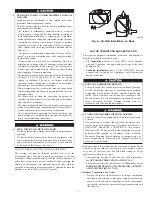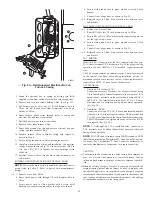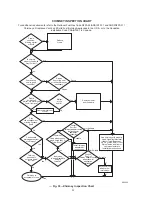
Bottom Return Air Inlet
These furnaces are shipped with bottom closure panel installed in
bottom return-air opening. Remove and discard this panel when
bottom return air is used. To remove bottom closure panel,
perform the following:
1. Tilt or raise furnace and remove 2 screws holding bottom filler
panel. (See Fig. 9.)
2. Rotate bottom filler panel downward to release holding tabs.
3. Remove bottom closure panel.
4. Reinstall bottom filler panel and screws.
Side Return Air Inlet
These furnaces are shipped with bottom closure panel installed in
bottom return-air opening. This panel MUST be in place when side
return air inlet(s) is used without a bottom return air inlet.
Not all horizontal furnaces are approved for side return air
connections. (See Fig. 20.)
FILTER ARRANGEMENT
FIRE, CARBON MONOXIDE AND POISONING
HAZARD
Failure to follow this warning could result in fire, personal
injury, or death.
Never operate a furnace without a filter or with filter access
door removed.
There are no provisions for an internal filter rack in these furnaces.
Deluxe furnaces are shipped with a factory supplied Media Filter
Cabinet. The Media Filter Cabinet uses either the factory-supplied
standard 1–in. filter or a 4–in. wide Media Filter which can be
purchased separately.
Refer to the instructions supplied with Media Cabinet for assembly
and installation options.
AIR DUCTS
General Requirements
The duct system should be designed and sized according to
accepted national standards such as those published by: Air
Conditioning Contractors Association (ACCA), Sheet Metal and
Air Conditioning Contractors National Association (SMACNA) or
American Society of Heating, Refrigerating and Air Conditioning
Engineers (ASHRAE) or consult The Air Systems Design Guide-
lines reference tables available from your local distributor. The
duct system should be sized to handle the required system design
CFM at the design external static pressure. The furnace airflow
rates are provided in Table 5-AIR DELIVERY-CFM (With Filter).
When a furnace is installed so that the supply ducts carry air
circulated by the furnace to areas outside the space containing the
furnace, the return air shall also be handled by duct(s) sealed to the
furnace casing and terminating outside the space containing the
furnace.
Secure ductwork with proper fasteners for type of ductwork used.
Seal supply- and return-duct connections to furnace with code
approved tape or duct sealer.
NOTE:
Flexible connections should be used between ductwork
and furnace to prevent transmission of vibration. Ductwork pass-
ing through unconditioned space should be insulated and sealed to
enhance system performance. When air conditioning is used, a
vapor barrier is recommended.
Maintain a 1-in. clearance from combustible materials to supply air
ductwork for a distance of 36 in. horizontally from the furnace. See
NFPA 90B or local code for further requirements.
Ductwork Acoustical Treatment
NOTE:
Metal duct systems that do not have a 90 degree elbow
and 10 ft of main duct to the first branch take-off may require
internal acoustical lining. As an alternative, fibrous ductwork may
be used if constructed and installed in accordance with the latest
edition of SMACNA construction standard on fibrous glass ducts.
Both acoustical lining and fibrous ductwork shall comply with
NFPA 90B as tested by UL Standard 181 for Class 1 Rigid air
ducts.
Supply Air Connections
For a furnace not equipped with a cooling coil, the outlet duct shall
be provided with a removable access panel. This opening shall be
accessible when the furnace is installed and shall be of such a size
that the heat exchanger can be viewed for possible openings using
light assistance or a probe can be inserted for sampling the air
stream. The cover attachment shall prevent leaks.
Fig. 14—Duct Flanges
A02329
UPFLOW
OWNFLOW
HORIZONTAL
PREFERRED
PERMITTED
PREFERRED
PREFERRED
PREFERRED
120˚
MIN
PREFERRED
120˚
MIN
PREFERRED
120˚
MIN
90˚
90˚
PERMITTED
PERMITTED
D
13
→












































